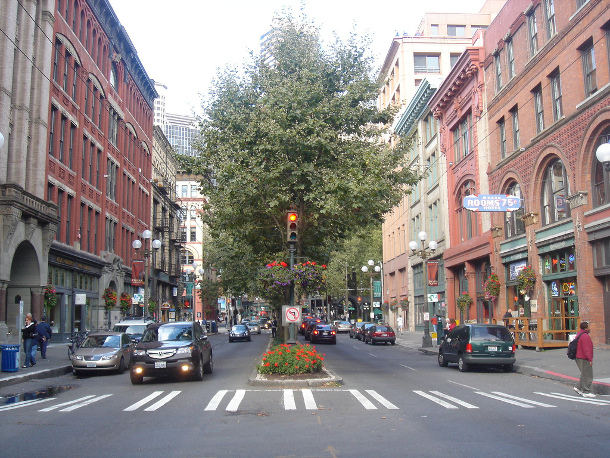In August, Seattle released their Urban Forest Stewardship Plan, the first comprehensive update to the previous Urban Forest Management Plan (2007) that set the goal of increasing Seattle’s tree canopy cover to 30 percent by 2037.
The 2013 Plan is broken up in six sections: guiding principles and integrated approach, the importance of Seattle’s urban forest, the current condition of Seattle’s urban forest, current stewardship and management efforts, goals and actions for moving forward, and future research and assessment needs. I took a quick look through to see how the plan treated two of our favorite topics: soil volume and green infrastructure.
On soils and rooting space, the plan included this paragraph on page 48:
Soils conditions affect tree growth and development and are influenced by activities that occur in urban environments. Soils are living systems that require a balance of adequate aeration and moisture retention to support the presence of organic material and microbial activity and provide adequate space for healthy root systems. It is important to avoid the problems with soil compaction, reduced soil aeration, and erosion often associated with construction in order to protect existing trees and provide appropriate soil conditions to encourage tree growth and development. In order for trees to thrive, they need sufficient soil volume and sufficient growing space. Providing sufficient volume is sometimes difficult due to competing land uses in a city that is striving to become denser while still remaining livable.
This gives a good overview of the issues, but it would have been great to include a more detailed discussion of solutions to provide urban trees with adequate soil in tight urban spaces like streets, plazas, and sidewalks. Designers are already very aware of how difficult it is to grow trees in cities – a focus on potential solutions or standards would have been incredibly valuable.
On green infrastructure, the plan included this paragraph on page 50:
The high percentage of area given to buildings and parking lots creates a challenge for accommodating trees, but also creates opportunities for incorporating other strategies such as green roofs, swales, and pervious pavements. These low-impact development approaches should be encouraged but should also be carefully monitored to determine how they affect the opportunities for new trees through competition for space and the weakening of existing trees by changing soil and hydrology conditions.
Again, this provides a basic overview of green infrastructure, but skimps on detail. For example, it doesn’t go in to any amount of detail about using trees and soils to manage urban stormwater. It also doesn’t delve in to any discussion about the city’s stormwater code, SMC Title 22 Subtitle VIII, which gives credit for trees and other green infrastructure in determining requirements for new development.
The last section of the plan is all about taking action, and includes a lot of great, detailed steps that the city plans to implement around the preservation and maintenance of existing trees, and well as the planning and care of new ones. The short-term action items I was most excited to see were:
1) Develop metrics for soil volume, soil compaction, soil type, species, diversity, and hydrologic information to help create sustainable forests requiring less maintenance. (OSE, IDT)
2) Explore opportunities to maximize available planting space by using existing and new technologies such as root barriers, Silva Cells, and/ or specialized soil mixes. (SDOT, DPD, Parks, Seattle Center FAS, SPU)
3) Improve design of street tree pits, including standards for soil volume, soil composition, and minimizing issues with tree grates. (SDOT)
What will Seattle make of their plan and their urban forest? Hopefully something wonderful. My hopes are pinned on a soil volume minimum and a comprehensive approach to using trees and soils to manage daily rainfall events, but time will tell. You can read the entire plan here.
Top image of a Seattle street tree. Flickr credit: Dave Reid
Header image: David Herrera






Leave Your Comment